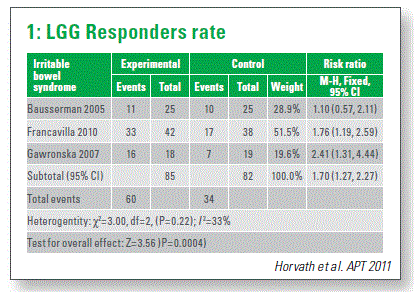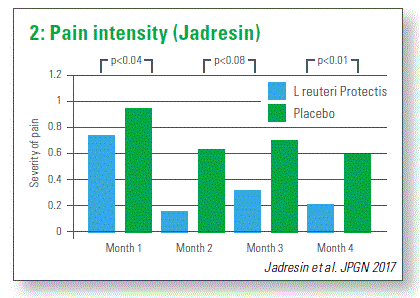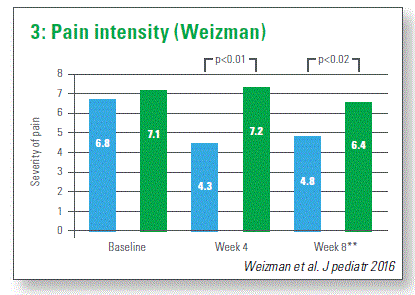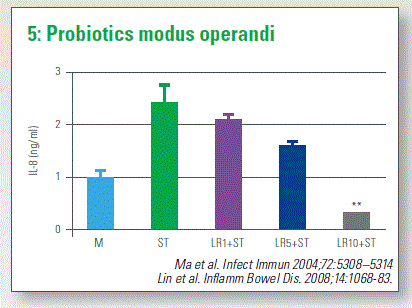FGID and the role of probiotics
FGID and the role of probiotics
Iva Hojsak
For the functional abdominal pain disorders or painrelated FGID, we have four categories in the Rome IV criteria: functional dyspepsia, irritable bowel syndrome (IBS), abdominal migraine and functional abdominal pain, now characterized as “not otherwise specified.” Here I would try to focus more on the children who were older than infant age, meaning toddlers and older children.
Irritable bowel syndrome (IBS) and functional abdominal pain (FAP) are the most frequent functional abdominal pain disorders and furthermore we have much more evidence of the role of probiotics with those two FGID. The etiology seems to be similar in infants and older kids. We know that those patients do have genetic predisposition, they have higher incidence of early life events or psychological factors. We know that the FAP or IBS can start unusually often after an infection and it has been shown that those patients who have a mild inflammation have altered gut microbiome. Importantly, it has been shown that patients with FGID have altered visceral sensitivity or hypersensitivity which is a part of the brain-gut axis.
Diagnosis and treatment
The problem that every physician is facing is how to diagnose the FGID the lack of proper biomarker led to the development of different criteria, from which widely accepted are Rome criteria. Newest version of the Rome criteria, are Rome IV criteria which emphasize the importance of the positive rather than the negative diagnosis. We should aim that the parents and the child will leave the physician’s office knowing that they have some sort of FGID. We have shown in our study that patients who were diagnosed with FAP on the first visit had a tendency to decrease their symptoms on the second visit compared to children who were not aware of the nature of their disease at the beginning. Sometimes, physicians tend to underestimate importance of symptoms in children with functional problems, however, it has been shown that the emotional burden associated with chronic abdominal pain is enormous, regardless whether the pain is functional or caused by organic disease. Furthermore, quality of life is significantly decreased.
Therefore, we are still trying to find proper treatment strategy. As pharmacological treatments, we use different antispasmodics, antidepressants, antihistaminic and laxatives. However, in general we lack high-quality, placebo-controlled, randomized studies in children which will indicate which of the pharmacological treatments are effective.
For non-pharmacological treatment, we have diet modifications. We know that lactose-free diet is not efficacious in the FAP. For FODMAP diet for IBS, we have one randomized control trial (RCT) which included 33 children and they showed improvement of symptoms in adolescents with IBS. There is more evidence for hypnotherapy and cognitive behavioral therapy, even the meta-analysis shows that they are effective, however, they are not widely available.
Probiotics
There are 10 RCT which investigated the effectiveness of probiotics in pain-related GI disorders, where 745 children were included. They evaluated altogether 4 strains or combinations of strains. Three trials investigated LGG, 5 Lactobcillus reuteri DSM 17938 and 2 multi-strain probiotic products. LGG studies mainly focused on IBS, while the L reuteri DSM 17938 focused more on FPA “not otherwise specified” (Chart 1).

With LGG, the design differs between the trials. What is the meta-analysis saying about the effectiveness of LGG in the treatment of a FGID? In general, the responders’ rate was significantly better in the arm when the LGG was used and that was most pronounced in the IBS, at the FAP there was no difference. Frequency of the pain significantly decreased in the LGG group compared to placebo. That was also more pronounced in IBS compared to FGID, where there was no difference. Severity of the pain decreased also most pronouncedly in the IBS, while in the FGID there was no difference. At L. reuteri DSM 17938 again we have some differences in the design of the trial, but all studies had the follow-up after the intervention. Looking at the meta-analysis, the severity of pain was signi- ficantly reduced in FAP for L. reuteri strain. When we look closely at every study, 3 of the 4 RCT found a decrease in the severity of pain in probiotic group and a significantly higher number of pain-free days happened in children who received L. reuteri compared to placebo (Charts 2–4).



One thing that I want to stress is the importance of placebo as well. It was shown in our study, and it was also found by others, that there is significant decrease in the severity of symptoms in the placebo arms. Almost 40–50% improved only by taking the placebo.
Probiotics can improve or change the microbiome at least during the time that we are giving them. We know that some probiotics strains have the ability to decrease the amount in vitro studies of pro inflammatory cytokine and L. reuteri was able to decrease in vitro but also in vivo the sensory of pain which was triggered by capsaicin and distension-evoked firing of spinal nerve action potentials (Chart 5).

Can we introduce the probiotics earlier, especially taking into account the new RCT, but also taking into account effectiveness of placebo? So in some pro- portion of patients we can consider the probiotics as a first step together with reassurance and education.
Constipation and probiotics
Constipation has a high prevalence of around 9% worldwide and more than 90% have no underlying organic cause. The etiology is multifactorial according to age: withholding behavior is very important especially in toddlers, psychological factors and social conditions but also alterations in intestinal microbiota. Based on the ESPGHAN and the NASPGHAN guidelines for the treatment of functional constipation, it has been proposed that polyethylene glycol (PEG) should be the first-line treatment and these guidelines do not recommend the usage of the probiotics for the treatment of childhood constipation.
It has been shown that ¼ of children who are having constipation during childhood will still have the problem in adolescence and also during adulthood.
Probiotics seem to have some promising effect, at least in the in vitro studies, where it has been shown that they reduce the transit time in the colon.
That was furthermore pronounced in adult studies, where the meta-analysis shows that probiotics in general decrease the gut transit time by 12 hours. They also increase the stool frequency by a 1.3 bowel movements/wk. There is also a strain- and species-specific effect, where all these meta-analyses advocate for specific probiotic strains.
Probiotics and constipation in children
However, in children, we have 9 RCT, with 677 in- cluded patients. But most of those studies use different probiotics and different strains; they had different protocols, different designs and they used the probiotics at different ages. The meta-analysis from last year shows that there is no effect on the usage of probiotics as an add-on treatment to the laxative in children with functional constipation.
This meta-analysis was published before these last 2 RCT, which were quite big in toddlers and older children. One is the Polish study, where they used the L. reuteri DSM 17938 in children who were > 3 years of age together with PEG and they found no effect. Similar as in our study, where we used the L. reuteri together with lactulose and we found no extra effect of adding probiotics to the lactulose. These two studies are quite different to the Italian study published in 2010 which was performed in infants and no laxative treatment was given. The difference could be at least partially explained by the fact that last two studies included toddlers, so the pathomechanism of the constipation is quite different compared to infants. There is also the difference in the laxative because these two studies use laxatives and we know that PEG and lactulose can influence the intestinal microbiome.
Conclusion
- Probiotics are not the same
- Only strains proven for specific clinical condition/indication should be recommended
- Advising the usage of probotics, we should consider:
- FAP/IBS - give positive diagnosis
- To consider:
* LGG for IBS
* L. reuteri DSM 17938 for FAP
- For constipation:
* Current evidence limited